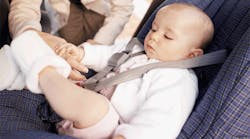The U.S. Department of Transportation (DOT), the National Highway Traffic Safety Administration (NHTSA) and Safe Kids recently kicked off Child Passenger Safety Week, held Sept. 16-22, to ensure the proper use and installation of child safety seats.
"Child safety seats save hundreds of young lives every year, but proper use is vital," said NHTSA Administrator David Strickland. "That's why we're urging everyone to make sure their kids are properly protected on every trip, every time."
A new NHTSA survey shows that parents are making five significant mistakes when using car seats and booster seats:
- The harness straps used to hold the child in the car seat were positioned either too low or too high.
- The harness chest clip was positioned over the abdomen rather than the chest or not used at all.
- The restraint system moved more than 2 inches side to side or front to back – anything more than one inch is too much.
- More than 2 inches of total slack between the child and the harness strap were found – there should be no slack.
- Improper seat belt placement left the lap belt resting over the stomach and/or shoulder belt on the child's neck or face.
The survey also revealed that 20 percent of all drivers of child passengers did not read any instructions on how to properly install their child restraints, yet 90 percent felt “confident” or “very confident” that their car seats and booster seats were installed correctly.
To help parents ensure their child seats are installed and used correctly, Safe Kids and NHTSA encourage all parents and caregivers to read vehicle and car seat instruction manuals and to take 15 minutes conduct the following safety checkup:
- Right Seat. Check the label on your car seat to make sure it's appropriate for your child's age, weight and height.
- Right Place. Keep all children in the back seat until they are 13. Doing this, along with correctly using the appropriate child restraints, greatly reduces the risk of injury.
- Right Direction. Keep your child in a rear-facing car seat for as long as possible. When he or she outgrows the seat, move your child to a forward-facing car seat. Make sure to attach the top tether after you tighten and lock the seat belt or lower anchors.
- Inch Test. Once your car seat is installed, give it a good shake at the base. Can you move it more than an inch side to side or front to back? A properly installed seat will not move more than an inch.
- Pinch Test. Make sure the harness is tightly buckled and coming from the correct slots (check the manual). Now, with the chest clip placed at armpit level, pinch the strap at your child's shoulder. If you are unable to pinch any excess webbing, you're good to go.
Parents are encouraged to read the vehicle and car seat instruction manuals in addition to following the checklist.
"Child safety seats can significantly reduce the risk of death or injury in the event of a crash," said Safe Kids President and CEO Kate Carr. "Engineers are working hard to ensure cars and car seats are designed to keep kids as safe as possible. But it's up to every parent to take full advantage of these innovations by making sure car seats are used and installed correctly.”
Learn more about Child Passenger Safety Week and NHTSA's Research Note on the National Child Restraint Use Special Study, or download the Safe Kids checklist.

